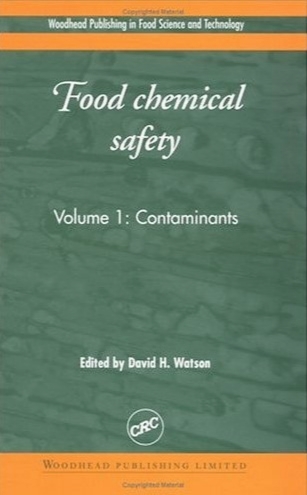Food chemical safety. Vol. 1, Contaminants
- نوع فایل : کتاب
- زبان : انگلیسی
- مؤلف : D H Watson
- ناشر : Cambridge : Woodhead
- چاپ و سال / کشور: 2001
- شابک / ISBN : 9781855734623
Description
List of contributors 1 Introduction D. Watson, Food Standards Agency, London 1.1 Background 1.2 Pesticides 1.3 Veterinary drugs 1.4 Persistent environmental chemicals 1.5 Processing contaminants 1.6 Migration from materials and articles in contact with food 1.7 Naturally occurring toxicants 1.8 Control measures 1.9 Current and future trends 1.10 Dedication and acknowledgement 1.11 References Part I Analytical methods 2 Risk analysis D. R. Tennant, Consultant, UK 2.1 Introduction 2.2 Hazard identification in the food supply chain 2.3 Dose-response characterisation 2.4 Exposure analysis 2.5 Risk evaluation 2.6 Methods for risk management Contents © 2001 Woodhead Publishing Ltd. 2.7 Future trends in risk analysis 2.8 Sources of further information and advice 2.9 References 3 Analytical methods: quality control and selection R. Wood, Food Standards Agency, London 3.1 Introduction 3.2 Legislative requirements 3.3 FSA surveillance requirements 3.4 Laboratory accreditation and quality control 3.5 Proficiency testing 3.6 Analytical methods 3.7 Standardised methods of analysis for contaminants 3.8 The future direction for methods of analysis 3.9 References Appendix: Information for potential contractors on the analytical quality assurance requirements for food chemical surveillance exercises 4 Molecular imprint-based sensors in contaminant analysis P. D. Patel, Leatherhead Food Research Association 4.1 Introduction 4.2 The principles of molecularly imprinted polymer-based techniques 4.3 The development and application of MIP-based sensors 4.4 Case studies: contaminant analysis 4.5 Future trends 4.6 Sources of further information and advice 4.7 Acknowledgements 4.8 References 5 Bioassays in contaminant analysis L. A. P. Hoogenboom, State Institute for Quality Control of Agricultural Products (RIKILT), Wageningen 5.1 Introduction 5.2 Dioxins and the DR-CALUX bioassay 5.3 The use of bioassays for other groups of compounds 5.4 Future developments 5.5 Acknowledgements 5.6 References © 2001 Woodhead Publishing Ltd. Part II Particular contaminants 6 Veterinary drug residues S. N. Dixon, Food Standards Agency, London 6.1 Introduction 6.2 Control of veterinary products in the UK 6.3 Chemical substances commonly used in veterinary medicines 6.4 Surveillance for veterinary drug residues 6.5 Analytical methods employed in drug residues surveillance 6.6 Results of surveillance for veterinary drug residues in the UK (1998) 6.7 Potential effects on human health of veterinary drug residues in food 6.8 Current issues relating to residues of veterinary drugs in food in the UK 6.9 Summary 6.10 Further reading 7 Inorganic contaminants in food N. Harrison, Food Standards Agency, London 7.1 Introduction 7.2 Metals and metalloids 7.3 Nitrate and nitrite 7.4 References 8 Environmental organic contaminants in food N. Harrison, Food Standards Agency, London 8.1 Introduction 8.2 Aromatic hydrocarbons 8.3 Polycyclic aromatic hydrocarbons 8.4 Dioxins and PCBs 8.5 Chlorinated hydrocarbons 8.6 Phthalic acid esters 8.7 Endrocrine disrupters 8.8 References 9 Chemical migration from food packaging L. Castle, Ministry of Agriculture, Fisheries and Food, York 9.1 Introduction 9.2 Chemical migration and the main factors that control it 9.3 The range and sources of chemicals in food packaging that pose a potential risk 9.4 Research on health issues 9.5 Regulatory context © 2001 Woodhead Publishing Ltd. 9.6 Migration testing 9.7 Case studies 9.8 Suggested further reading 10 Pesticides I. Shaw and R. Vannoort, Institute of Environmental Science and Research, Christchurch 10.1 Introduction 10.2 Monitoring pesticides in food 10.3 High risk groups 10.4 The UK’s approach to pesticide surveillance 10.5 Findings from the UK pesticide monitoring scheme 10.6 Human exposure monitoring 10.7 Should we ban pesticides? 10.8 References 11 Mycotoxins J. E. Smith, University of Strathclyde, Glasgow 11.1 Introduction 11.2 Health implications of mycotoxins 11.3 Analytical methods 11.4 Application of HACCP systems to reduce mycotoxin presence 11.5 Prevention and control of mycotoxins 11.6 Conclusion and future trends 11.7 References Part III Regulation 12 The international regulation of chemical contaminants in food T. Berg, Danish Veterinary and Food Administration, Soborg 12.1 Introduction 12.2 The nature of international regulation: Codex Alimentarius 12.3 Decision making and enforcement mechanisms 12.4 The Codex General Standard on Contaminants and Toxins in Food 12.5 Future trends 12.6 Sources of further information and advice 12.7 References © 2001 Woodhead Publishing Ltd. 13 The regulation of chemical contaminants in foodstuffs in the European Union S. A. Slorach, National Food Administration, Uppsala 13.1 Introduction 13.2 Scientific advisory committees 13.3 Pesticide residues 13.4 Veterinary drug residues 13.5 Mercury and histamine in fishery products 13.6 Other chemical contaminants 13.7 Future trends 13.8 References 14 Contaminant regulation and management in the United States: the case of pesticides C. K. Winter, University of California, Davis 14.1 Introduction 14.2 Pesticide regulation in the US 14.3 Regulatory monitoring of pesticides in the US 14.4 Managing pesticides in foods in the US 14.5 Improving the management of pesticides in foods 14.6 Future trends 14.7 Further information and advice 14.8 References © 2001 Woodhead Publishing Ltd.


